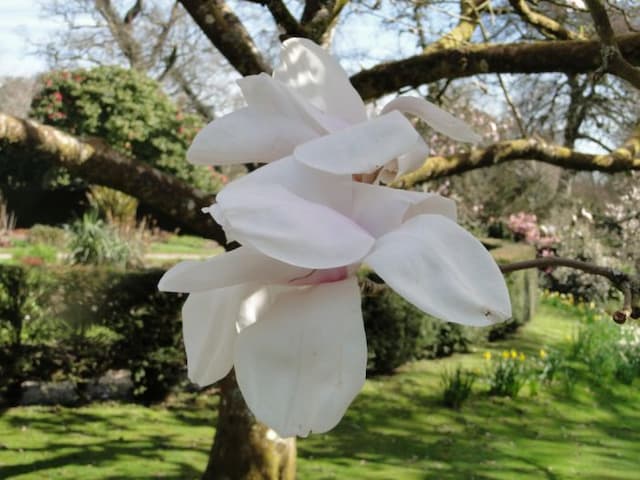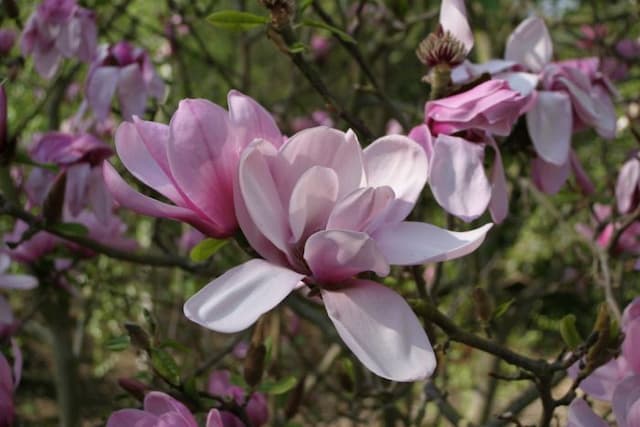Chinese Tulip Tree Liriodendron chinense

ABOUT
The Chinese tulip tree is adorned with large, lustrous green leaves that have a unique, almost saddle-like shape. In spring and summer, it blooms with tulip-shaped flowers that display an attractive array of colors, usually a creamy green or pale yellow with a splash of orange at the base. These flowers provide a striking contrast against the foliage. The bark of the Chinese tulip tree is gray and can be ridged or furrowed, giving the trunk and branches a textured appearance. After flowering, the plant produces brown, cone-like seed clusters that can hang on the tree throughout winter, offering an interesting visual aspect. Overall, the Chinese tulip tree is known for its distinct leaf shape and stunning, tulip-like flowers that add a touch of exotic charm to any setting where they are grown.
About this plant
 Names
NamesFamily
Magnoliaceae
Synonyms
Chinese Tulip Tree, Chinese Whitewood
Common names
Liriodendron procera, Liriodendron tulipifera var. chinense.
 Toxicity
ToxicityTo humans
The Chinese tulip tree is generally not considered toxic to humans. However, as with many plants, sensitive individuals may experience mild stomach upset if any parts of the plant are ingested without appropriate preparation. It is always advisable to exercise caution and avoid eating any part of ornamental plants unless they are known to be edible.
To pets
The Chinese tulip tree is not typically listed as toxic to pets such as dogs and cats. However, ingestion of large amounts of plant material by pets may lead to gastrointestinal upset, including vomiting and diarrhea, due to the natural defense mechanisms of the plant or from the simple fact that it is not a usual part of the animal's diet. If you suspect your pet has ingested a significant quantity of the Chinese tulip tree, it is best to consult a veterinarian.
 Characteristics
CharacteristicsLife cycle
Perennials
Foliage type
Deciduous
Color of leaves
Green
Flower color
Yellowish-green
Height
60 feet (18 meters)
Spread
35 feet (10.7 meters)
Plant type
Tree
Hardiness zones
6
Native area
China
Benefits
 General Benefits
General Benefits- Ornamental Value: The Chinese tulip tree is known for its attractive foliage and tulip-like flowers, making it a popular choice for landscape design.
- Shade Provision: With its broad canopy, Liriodendron chinense can provide significant shade in parks, gardens, and urban streets.
- Wood Production: The wood of the Chinese tulip tree is utilized in furniture and woodworking due to its workability and fine grain.
- Habitat for Wildlife: The tree offers habitat and food sources for various species of birds, insects, and small mammals.
- Carbon Sequestration: As a large deciduous tree, it plays a role in capturing carbon dioxide, thus contributing to the mitigation of climate change.
 Medical Properties
Medical Properties- Anti-inflammatory: Liriodendron chinense has been reported to contain compounds with potential anti-inflammatory effects.
- Antibacterial: Extracts from the plant may have antibacterial properties against certain strains of bacteria.
- Antitumor: Some studies suggest that compounds in Liriodendron chinense could have antitumor activities.
- Antioxidant: The plant may contain antioxidants which help in protecting the body from oxidative stress.
 Air-purifying Qualities
Air-purifying QualitiesThis plant is not specifically known for air purifying qualities.
 Other Uses
Other Uses- Woodworking: The wood of the Chinese Tulip Tree is often used in fine woodworking for items such as furniture and musical instruments due to its workability and aesthetic grain patterns.
- Landscape Design: Due to its large size and attractive flowers, the Chinese Tulip Tree is planted as a feature or shade tree in large gardens and parks.
- Beekeeping: The flowers of the Chinese Tulip Tree produce nectar that is appreciated by bees, making it a beneficial plant for honey production.
- Art and Craft: The bark and leaves of the Chinese Tulip Tree may be used in various art and craft projects, such as making natural imprints on fabric or paper.
- Education and Research: Botanists and horticulturalists study the Chinese Tulip Tree for its unique phylogenetic position as part of the magnolia family.
- Culinary: In some regions, the flowers of the Chinese Tulip Tree are used as edible decorations or are candied for use in desserts.
- Folk Art: In certain cultures, parts of the tree, such as dried leaves or sections of bark, are integrated into traditional decorative arts.
- Photography and Painting: The Chinese Tulip Tree's striking appearance, especially when in bloom, makes it a popular subject for photographers and painters.
- Religious and Ceremonial: The tree may hold symbolic significance and be used in various religious or ceremonial practices in different cultures.
- Seasonal Festivities: Branches and flowers of the Chinese Tulip Tree might be used to create festive decor, especially in East Asian cultures where it is indigenous.
Interesting Facts
 Feng Shui
Feng ShuiThe plant_name is not used in Feng Shui practice.
 Zodiac Sign Compitability
Zodiac Sign CompitabilityThe plant_name is not used in astrology practice.
 Plant Symbolism
Plant Symbolism- Beauty: The Chinese tulip tree (Liriodendron chinense) is known for its stunning flowers and majestic form, making it a symbol of natural beauty and grace.
- Rareness: This species, being less common than its American relative, can symbolize uniqueness or rarity.
- Healing: In some cultures, parts of the tree are used in traditional medicine, symbolizing healing and therapeutic properties.
- Longevity: As a long-lived tree species, the Chinese tulip tree represents endurance and long life.
 Water
WaterChinese tulip trees need a consistent watering schedule, especially during their growing season in spring and summer. Young trees should be watered thoroughly, ensuring the soil is moist to a depth of 6 to 9 inches, which could roughly translate to about 1 to 2 gallons per week depending on the soil type and weather conditions. During hot and dry spells, increase the frequency to twice a week. Once established, they are more drought-tolerant but still prefer a deep watering every two to three weeks if there isn't significant rainfall. It's crucial to avoid overwatering which can lead to root rot.
 Light
LightChinese tulip trees thrive best in full sunlight, which means they should receive at least six hours of direct, unfiltered sunlight each day. The ideal spot for planting a Chinese tulip tree is an area that gets plenty of morning sunlight and some afternoon shade, especially in hotter climates to avoid scorching.
 Temperature
TemperatureThe Chinese tulip tree is tolerant of a range of temperatures but grows best when the thermometer reads between 60°F and 80°F. It can survive minimum temperatures down to about -20°F once established. Prolonged exposure to temperatures above 90°F or below -20°F should be avoided as it may stress the tree.
 Pruning
PruningPrune the Chinese tulip tree to maintain its shape and remove any damaged or diseased branches. The best time to prune is during late winter or early spring before new growth starts. Pruning should be done annually or as needed, with particular attention to crossing or rubbing branches that can cause wounds and invite pests or disease.
 Cleaning
CleaningAs needed
 Soil
SoilThe Chinese Tulip Tree thrives in moist, well-draining, slightly acidic to neutral soil with a pH of 5.5 to 7.0. A mix of loamy soil, rich in organic matter with compost and leaf mold is ideal for ensuring strong growth.
 Repotting
RepottingThe Chinese Tulip Tree should be repotted every 3-5 years when young or if the roots outgrow the pot. Mature trees require less frequent repotting.
 Humidity & Misting
Humidity & MistingThe Chinese Tulip Tree prefers moderate to high humidity levels but can tolerate lower humidity typical of outdoor conditions.
 Suitable locations
Suitable locationsIndoor
Provide bright, indirect light and ample space for Chinese Tulip Tree.
Outdoor
Plant in moist, well-drained soil with full sun to partial shade.
Hardiness zone
6-9 USDA
 Life cycle
Life cycleThe Chinese Tulip Tree (Liriodendron chinense) begins its lifecycle with seed germination, which requires a period of cold stratification to break dormancy. Upon sprouting, the seedling stage is marked by the growth of basic root structures and a stem, eventually developing into juvenile leaves that are distinct from mature foliage. As the plant enters the sapling stage, it forms a woody stem and characteristic leaves, and continues to grow in height and girth. The maturity stage is reached when the tree starts flowering, typically after 15-20 years of growth, producing yellow-green flowers with an orange band at the base, which are pollinated by insects. Following pollination and fertilization, the tree produces seeds contained within cone-like aggregate fruits that, when mature, disperse to propagate new plants. The Chinese Tulip Tree can live for many decades, even centuries, continuing to flower and produce seeds annually, which contributes to the species' survival and distribution.
 Propogation
PropogationPropogation time
Spring-early summer
The Chinese Tulip Tree, Liriodendron chinense, is often propagated by seed which generally involves collecting seeds during the late summer or autumn when they are ripe. The seeds need to be stratified, a process that involves simulating natural conditions that seeds must experience before germination. This usually means keeping the seeds in moist sand or peat at a cold temperature, typically just above freezing (32°F or 0°C), for around 60-90 days. After stratification, seeds can be sown in pots or a prepared seedbed. If conditions are favorable, with warmth and moisture, germination will generally take place within a few weeks. Care should be taken to protect the seedlings from frost during their first winter.








![Magnolia [Felix Jury]](/_next/image?url=https%3A%2F%2Fplants-admin.emdemapps.com%2Fimages%2Fplants%2F%2Fimages%2F604b61a0b23b7.png&w=640&q=75)
